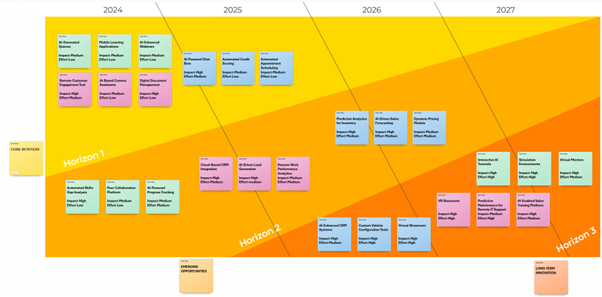Identifying and prioritizing AI use cases that can drive significant value is a challenge we see repeatedly with clients that are in the initial stages of their AI journey.
One of the tools we use to help our clients create an AI roadmap is the horizon-based framework. The horizon-based framework offers a structured method for categorizing and prioritizing AI initiatives, ensuring that businesses effectively leverage AI to optimize operations, enhance market positioning, and drive transformational change.
This blog post explores the framework in detail, providing practical insights to help you prioritize AI use cases within your organization.
Understanding the Horizon-Based Framework
The horizon-based framework, also known as the Three Horizons Framework, was created by McKinsey consultants Mehrdad Baghai, Stephen Coley, and David White in their 1999 book “The Alchemy of Growth: Practical Insights for Building the Enduring Enterprise.”
This strategic tool categorizes growth opportunities into three horizons to balance short-term performance with long-term growth.
Horizon 1: Optimizing Core Business Operations
- Focuses on enhancing existing processes for quick wins and measurable returns.
- Minimal risk and highly feasible, ideal for organizations new to AI.
Horizon 2: Improving Market Position
- Aims for medium-term projects that enhance competitive positioning.
- Involves more complexity and strategic alignment than Horizon 1.
Horizon 3: Transforming Business Models
- Targets long-term, transformational changes and new business models.
- Elevated levels of innovation and risk, leveraging the latest AI advancements.
Why the Horizon-Based Framework is Ideal for AI Use Cases
The Three Horizons Framework is well-suited for prioritizing AI use cases due to its structured approach to balancing immediate needs with future opportunities. Here is why it is effective:
- Balanced Perspective: It allows organizations to focus on immediate, incremental improvements while also planning for medium- and long-term strategic initiatives.
- Risk Management: By starting with smaller, low-risk projects in Horizon 1, businesses can build confidence and demonstrate value before tackling more ambitious projects.
- Resource Allocation: Helps in allocating resources effectively across different time horizons, ensuring both short-term performance and long-term growth are addressed.
- Strategic Alignment: The framework aligns AI initiatives with the broader business strategy, ensuring that each project contributes to the overall goals of the organization.

Data is Critical for AI
The evolution of your data estate is the key enabler to move from horizon to horizon. Learn more about preparing your data platform for AI.
Horizon 1: Optimizing Core Business Operations
Horizon 1 looks to enhance operational efficiency through quick, low-risk AI projects that provide immediate returns.
They are aimed at optimizing core business operations, streamlining processes, reducing costs, and improving productivity. These projects focus on improving existing processes and building confidence in AI.
Horizon 1 Examples
- Optimizing Transit Routes: AI analyzes traffic patterns and weather conditions to optimize routes, reducing fuel consumption and delivery times.
- Scoring Market Leads: AI enhances sales efforts by scoring leads based on conversion likelihood, improving resource allocation.
Horizon 1 Benefits
- Builds confidence in AI technologies.
- Establishes a foundation for future AI projects.
- Demonstrates quick, measurable wins.
Horizon 2: Improving Market Position
Horizon 2 focuses on strategic initiatives that provide competitive advantages.
These medium-term projects involve more complexity and aim to leverage AI to create new value propositions, improve customer experiences, and differentiate the business in the market.
Horizon 2 Examples
- Predictive Maintenance for Machinery: AI analyzes sensor data to predict equipment failures, allowing for proactive maintenance and reducing downtime.
- Detecting Fraudulent Behavior: AI identifies anomalies in transaction data to detect fraud in real-time, enhancing security.
Horizon 2 Benefits
- Enhances market position and competitive edge.
- Increases customer engagement through personalized experiences.
- Provides scalable solutions for broader applications.
Horizon 3: Transforming Business Models
Horizon 3 targets long-term, transformational AI projects that can redefine business models and create new revenue streams.
These initiatives involve high innovation and risk but offer substantial strategic gains.
Horizon 3 Examples
- Predicting Patient Outcomes in Healthcare: AI analyzes patient data to predict health outcomes, enabling personalized treatment plans.
- Interactive AI Agents for Employees: Advanced AI assistants automate routine tasks and provide decision support, enhancing workplace productivity.
Horizon 3 Benefits
- Drives innovation and industry leadership.
- Provides long-term competitive advantages.
- Creates new revenue streams and business models.
Ready to create your AI roadmap?
Contact us to accelerate your organization’s path to AI value
Implementing the Horizon-Based Framework
Implementing the horizon-based framework involves a strategic and systematic approach to ensure the successful adoption of AI initiatives across the different horizons.
Step 1: Identifying Potential AI Use Cases
- Conduct ideation workshops to gather cross-functional insights.
- Assess each use case for business impact and feasibility.
Step 2: Categorizing Use Cases into Horizons
- Classify use cases based on strategic goals and complexity.
- Develop a roadmap with timelines and key metrics.
Step 3: Prioritizing Use Cases
- Use criteria like business value and technical feasibility to prioritize projects.
- Focus on quick wins in Horizon 1 to build momentum.
Step 4: Implementing Horizon 1 Projects
- Start with low-risk, high-impact initiatives.
- Measure and report successes to build support for further AI investments.
Step 5: Expanding to Horizon 2 and 3
- Leverage early wins to tackle more complex projects.
- Prepare for transformational initiatives by investing in advanced AI technologies and your data platform.
Step 6: Continuous Evaluation and Adaptation
- Regularly review progress and adjust strategies based on new insights.
- Foster a culture of innovation and collaboration.
Conclusion
The horizon-based framework offers a structured approach to prioritizing AI use cases, balancing immediate needs with long-term goals.
By categorizing initiatives into three horizons, businesses can optimize current operations, enhance market positioning, and drive transformational change. This approach ensures your AI adoption aligns with business objectives, providing both immediate benefits and long-term growth opportunities.
If you are having challenges identifying AI use cases for your organization, give the horizon-based framework a try.
It centers the conversation on business objectives and challenges, which is where it should be. Remember, AI is an enabler of better performance, not the end game.




